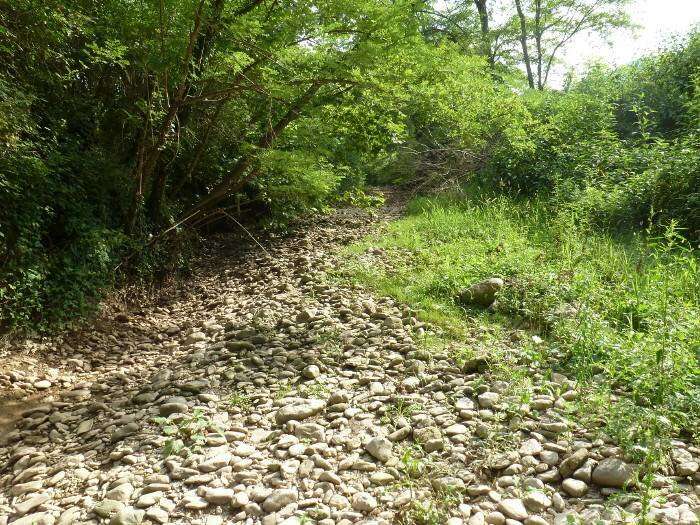Dry inland waters are underrated players in climate change

2018: A year of drought – climate change causes an increase in the number of freshwaters that run dry, at least temporarily. Also, many lakes are shrinking permanently or have disappeared completely. Around 90,000 square kilometres of water surface have already vanished in the last 30 years. This trend is not only a threat to drinking water reserves and major ecosystems – dried freshwaters also play an important role in the global carbon cycle, and may be responsible for the release of CO2 and other climate-relevant gases. Two recently published studies undertaken with involvement of the Leibniz-Institute of Freshwater Ecology and Inland Fisheries (IGB) reveal that the importance of this phenomenon has so far been underrated.
A key element of the Assessment Reports published by the Intergovernmental Panel on Climate Change (IPCC) is the global carbon cycle: carbon (C) exists in several different forms in rock, soils, water, air, organisms and the atmosphere; continuous exchange processes occur between these spheres. Carbon in the form of CO2 acts as a greenhouse gas in the atmosphere. "When calculating fluxes of matter in the carbon cycle, some habitats are too complex to capture, which is why they are not considered separately in the IPCC Report," explained Dr. Gabriel Singer, Leader of the IGB research group Fluvial Ecosystem Ecology and co-author of both studies. And yet rivers, lakes, ponds and streams that fall partially or completely dry, or that have falling water levels, may play a significant role in global CO2 emissions, as the team of authors show: when permanently dry lake sediments and seasonally dry surfaces of all different freshwaters are considered, estimates for CO2 fluxes from continental inland waters to the atmosphere must be increased by about 10%. As such, freshwaters play a more important role in the global carbon cycle than was previously assumed.
Lakes are considered to be carbon sinks – this is only true to a certain extent
The team analysed numerous publications that have contributed in recent years to determining CO2 emissions from freshwaters and their contribution to the carbon cycle, and the reasons for their increased desiccation. Strictly speaking, freshwaters, and lakes in particular, primarily act as C sinks – long-term carbon accumulation occurs in their sediments. If water levels fall, however, an increasing share of the lake bottom is exposed to atmospheric oxygen. The drier sediments become, the more aerobic respiration increases – dead organic matter in the lake bottom is used by bacteria, which leads in turn to the production of CO2. "Our analysis shows that lakes should not be considered just as C sinks; on the contrary, they emit gaseous carbon when they fall dry," emphasised Gabriel Singer. These effects are likely to increase in importance under a changing climate: on a global scale, for example, around 90,000 square kilometres of water surface have vanished completely in the last 30 years.
On the basis of the accumulated knowledge, the team of authors calculated an approximate base level for the proportion of the global carbon cycle that can be attributed to drying inland waters. "Around 0.2 gigatonnes of CO2 are emitted globally by dry inland waters each year. As a comparison: the annual CO2 flux from continental freshwaters is approx. 2 gigatonnes, and anthropogenic fluxes from fossil fuels total around 9 gigatonnes each year," stated Gabriel Singer. It is difficult to estimate the extent to which anthropogenic influences are responsible for the increase in aridity; potential influences are attributed to land use change in water catchment areas or to measures that cause the permanent drying of seasonally dry lakes following water removal. And, of course, local drying may also be a consequence of changes in temperature and rainfall associated with global climate change.
Reservoirs are potential targets for reducing CO2 emissions from inland waters
The results of the study offer mankind new courses of action. "The more we know about how the global carbon cycle works, the easier we can identify potential targets, particularly when it comes to absorbing the possible feedback effects of climate change," stated Gabriel Singer. Reservoirs, for example, are man-made waters where it is consciously accepted that areas of sediments repeatedly fall dry during water level fluctuations. It is essential to undertake a holistic assessment of the role played by such systems in the carbon cycle. This assessment also includes the provision of detailed information about greenhouse gas emissions. This particularly holds true when it comes to selecting sites for the construction of potential new reservoirs, but also with regard to how the management of existing reservoirs can be adapted or if, perhaps, such reservoirs should even be removed.
Another article by Gabriel Singer's team published recently explores the effects of alternating dry and wet phases in river ecosystems on fluxes of matter. During her time as a visiting young scientist at IGB, Marisa Arce investigated the existence of nitrogen in sediments, ammonia oxidation, and emissions of nitrous oxide, another important greenhouse gas. In fact, nitrous oxide decreases during dry periods, but increases again as soon as rainfall occurs. The findings help scientists understand more clearly the behaviour of nitrogen fluxes in rivers and streams exposed to alternating dry and wet phases. Due to climate change, such a scenario will affect a larger number of river ecosystems in the future – and may change the role they play in global matter cycles.
More information: Maria Isabel Arce et al. Drying and Rainfall Shape the Structure and Functioning of Nitrifying Microbial Communities in Riverbed Sediments, Frontiers in Microbiology (2018). DOI: 10.3389/fmicb.2018.02794
Rafael Marcé et al. Emissions from dry inland waters are a blind spot in the global carbon cycle, Earth-Science Reviews (2018). DOI: 10.1016/j.earscirev.2018.11.012
Provided by Forschungsverbund Berlin e.V. (FVB)

















